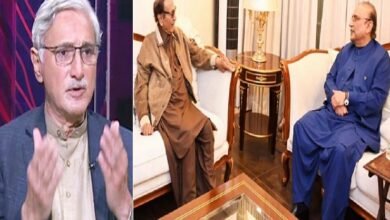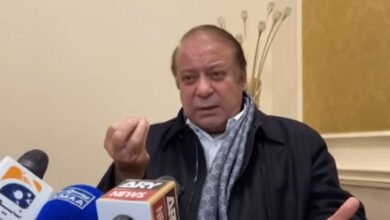Nawaz Sharif and Asif Ali Zardari: How past rulers used dictatorial ways to save their govts?
Nawaz Sharif and Asif Ali Zardari had used the same dictatorial practices during their tenures.

The biggest critics of Prime Minister Imran Khan-led Pakistan Tehreek-e-Insaf (PTI), Pakistan Muslim League Nawaz (PML-N) Nawaz Sharif and Pakistan People’s Party (PPP) Asif Ali Zardari had used the same dictatorial practices during their tenures of which they are criticising the incumbent government.
Nawaz Sharif and Asif Ali Zardari are among the top opposition leaders who are levelling allegations against the PTI government led by PM Imran Khan for using dictatorial tactics to save his government.
The criticism was launched by the two political parties following their patrons’ directives who are now fearing the imposition of a presidential rule and dictatorship in the country following the dissolution of the National Assembly.
Telegraph report
During his tenure, former president Asif Ali Zardari had banned jokes ridiculing him. He had been accused of suffering from a sense of humour failure after banning jokes ridiculing him, according to the Telegraph report published in 2009.
The then interior minister Rehman Malik had announced the Federal Investigation Agency (FIA) had been asked to trace electronically transmitted jokes that “slander the political leadership of the country” under the new Cyber Crimes Act. Pakistanis who send jokes about Asif Zardari by text message, email or blog risk had been warned that they could be arrested and given a 14-year prison sentence.
Malik had said the move would punish the authors of “ill motivated and concocted stories through emails and text messages against the civilian leadership”.
The step, which was described by human rights groups as “draconian and authoritarian”, came after the government was particularly riled by a barrage of caustic jokes being sent to the presidency’s official email.
Critics had accused the ruling Pakistan People’s Party (PPP), a party that espouses a liberal agenda, of stooping as low as the former military ruler, Pervez Musharraf, who took television broadcasters off air when he faced political opposition.
Mr Zardari had proved to be prickly about what others say of him since he was elected as president by the national parliament a year ago.
Most of the criticism stems from his government’s inability to address problems such as severe power outages and inflation, and his inability to shake off old allegations of corruption.
Mr Zardari’s thin-skin when it comes to jokes has forced Pakistanis to find other ways to refer to the president, with nicknames ranging from “dacu” or “bandit” to chief choor, meaning thief.
The ban has become the focus of intense television debate in Pakistan, as Mr Zardari’s aides have attempted to justify the move using every argument ranging from counter-terrorism concerns to saying that women parliamentarians had received abusive messages.
Mr Zardari’s PPP-led government had tried to target text messages and emails last month when it levied a new tax on all text messages. The tax was abandoned after it emerged that it would ruin a major source of revenue for Pakistan’s five mobile phone companies.
As soon as the tax was announced, a text message began making the rounds saying: “The government has imposed a tax on all messages. This means that until now President Zardari was getting abused for free. Now he’ll get paid every time someone abuses him!”
Nawaz Sharif’s religious card
When Pakistan’s Prime Minister Nawaz Sharif swept to power after winning an overwhelming mandate in the general elections, he told his countrymen: “We must go down on our knees and bow before Allah.”
They all believed it was only meant to be a gesture of thanksgiving. So no one was really prepared for what Sharif did last week when he found himself practically on his knees politically. He declared that henceforth the Shariat or the social system of Islam, whose central tenets are the Quran and the Sunnah (practices of the Prophet), would be the supreme law of the land.
In the National Assembly, where he proposed a bill to amend the Constitution, he declared somewhat poetically: “The nuclear tests changed the colour of the Chagai mountains and the Shariat Bill will change the colour of society.”
Few expected Sharif to change his colours so dramatically in the face of the country’s deepening financial and political crisis after the nuclear tests in May, according to a 1998’s article published in India Today. He was a protg of the late General Zia-ul-Haq, who ruled as a dictator when he was the President and had even made similar moves to make Islamic law supreme in 1985.
But Sharif still had the image of being a moderate politician, a leader who rode to power on a landslide electoral victory fought on bread and butter issues. So naturally his playing the Islamic card is seen as a desperate gamble to save his Government from collapse.
Already the move has isolated him politically with all his coalition partners, including the Muttahida Qaumi Movement and the National Awami Party, pulling out in protest. With the ruling Pakistan Muslim League occupying 137 seats in the 217-strong Assembly, just six short of a two-thirds majority, Sharif ‘s Government faces no immediate threat to its stability.
But there is growing concern within his country and internationally about what Sharif is really up to. For the Constitution already proclaims that Pakistan is an Islamic state and has vested the country’s sovereignty with Allah.
Sharif’s opponents believe he is pushing Pakistan into a dangerous form of religious dictatorship and is likely to declare himself Amir-ul-Momineen (leader of Muslims). It is a development that worries India with Prime Minister A.B. Vajpayee brushing aside diplomatic caution by stating that it was “a retrograde step” and adding, “the growth of religious extremism in any country is a matter of concern to us”.
So why did Sharif get himself into such a holy mess and what threat does a truly Islamic Pakistan pose to the region?
The Politics of Islam
If the enforcement of Islam had been the sole purpose behind the move, there was little need for Sharif to propose the 15th amendment to the Constitution, which already recognises Islam as the state religion of Pakistan.
The supremacy of Allah – which Sharif is now pushing for – was enshrined in the first Constitution, drafted in 1956 when the country was formally given the title of the “Islamic Republic of Pakistan”. Under the Constitution, the Government is already vested with powers to ensure that Muslims live in accordance with the fundamental principles of Islam.
“The most disturbing aspect of the bill is that it neither protects the federal character of our polity nor guarantees the fundamental rights which the Constitution enshrines,” says Khalid Jawed Khan, a leading constitutional lawyer.
“There is nothing in the bill which prevents the Government from concluding that the electoral system, the Parliament, the existence of provinces, the judiciary and political parties in their present form are un-Islamic and, therefore, should be replaced with a nominated Shoora (consultative body) of pious Muslims.”
What appears to have pushed Sharif along this dangerous path was 1996 the fact that his country was on the brink of bankruptcy. Sectarian strife, especially in Sindh, was again getting out of control.
Also Sharif, his aides say, felt his Government was sinking after the recent US strikes on Afghanistan and Sudan, when he was caught between trying to appease both the Taliban and the US.
At home, pressure on the Government increased after the right-wing parties organised street demonstrations against the strikes. Added to this was the siege mentality that seemed to grip Sharif after army Chief General Jehangir Karamat embarrassed him with his clarifications on the US missile strikes.
While Sharif maintained he had no prior notice of the strikes, Karamat issued what amounted to a public contradiction, saying the Americans had informed him and he, in turn, had informed the Government.



